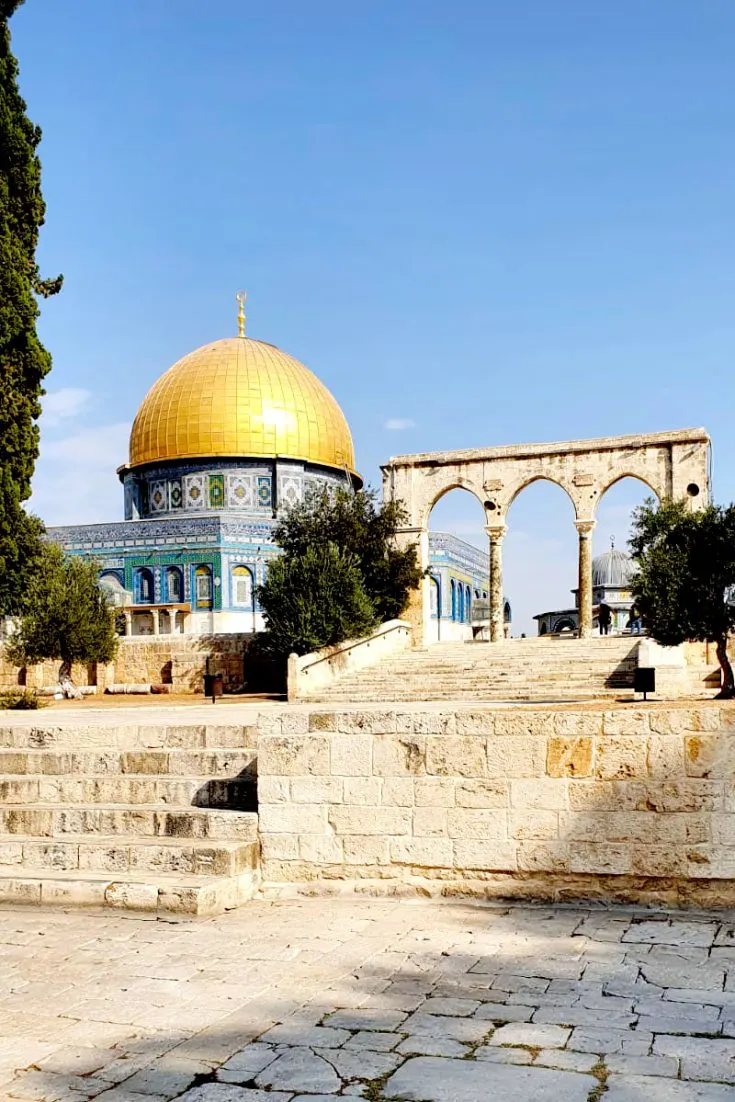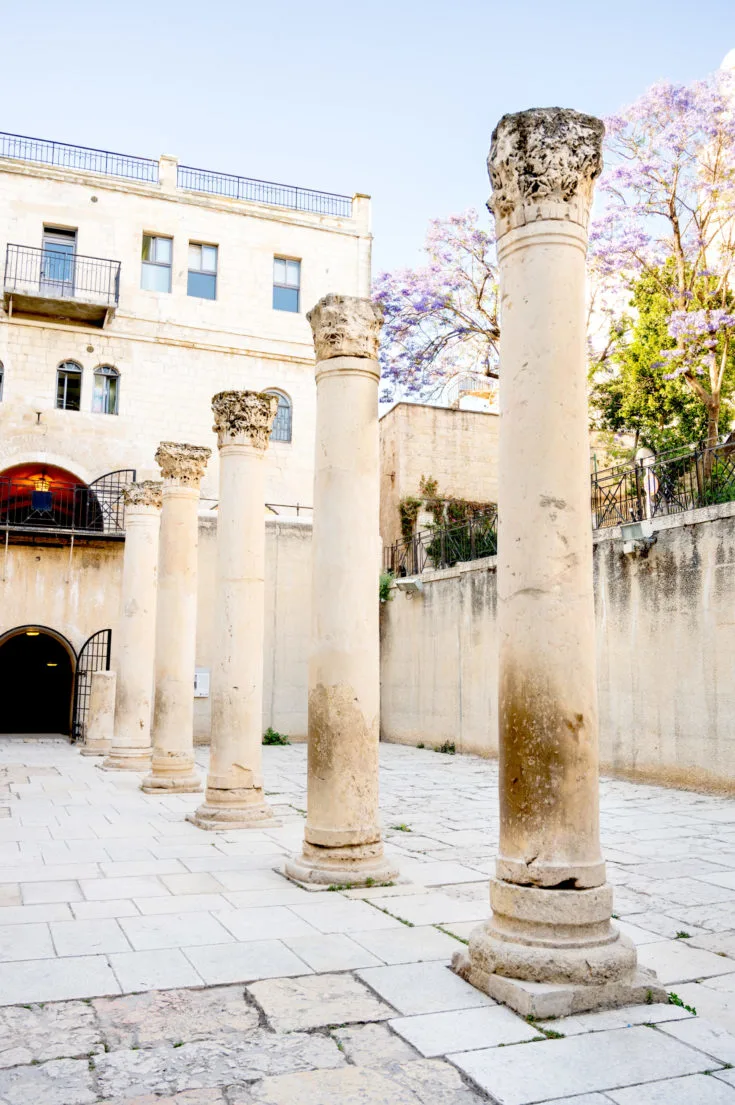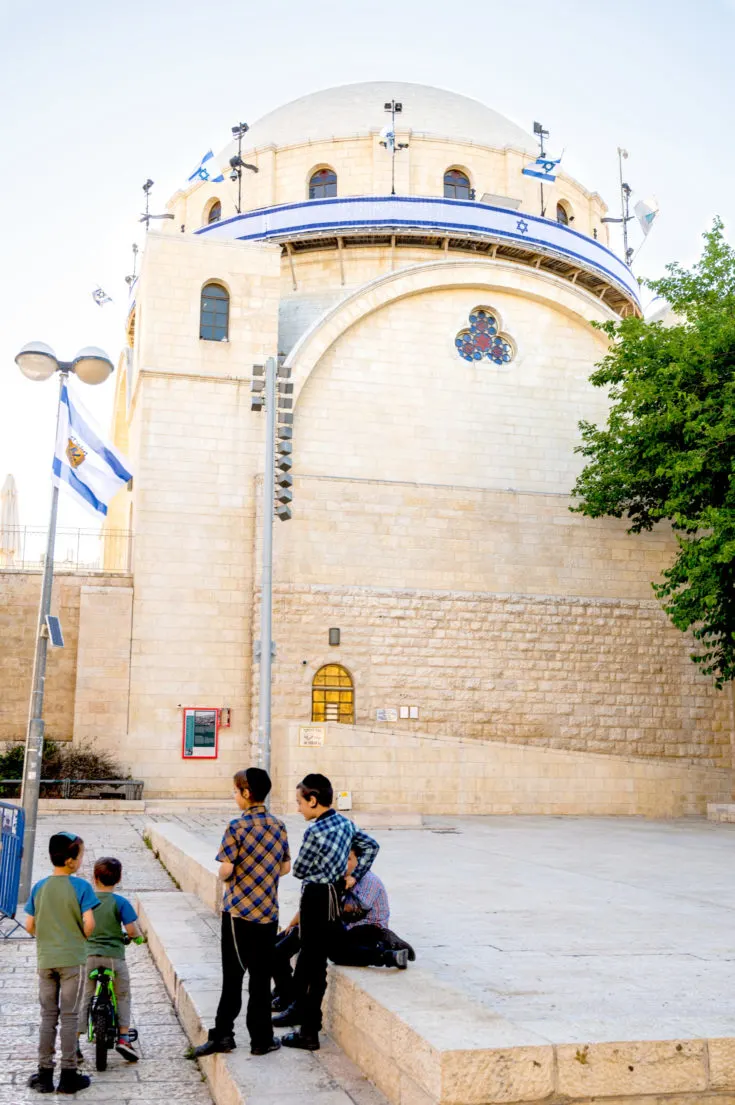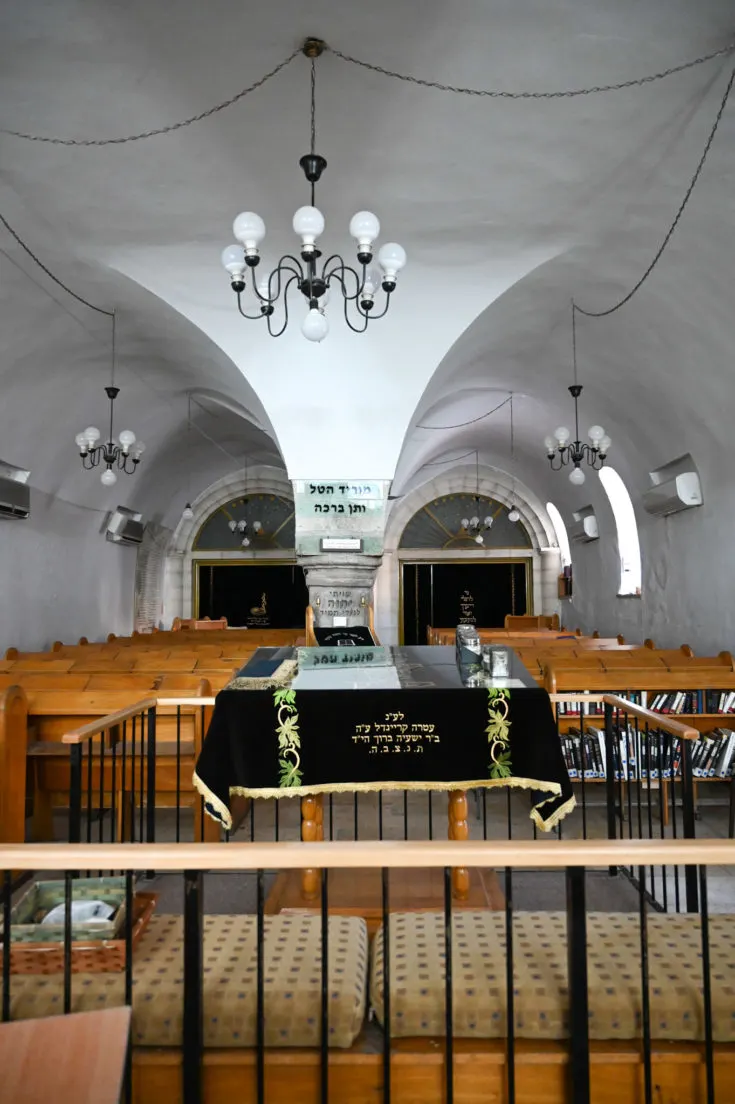If you are wondering what things there are to do in the Old City, wonder no more. It is a city filled rich history and culture.
There are museums, historical sites, archaeological sites, and of course, religious sites.
Here is the every growing ultimate list of things to do in the Old City.
Things To Do in The Old City of Jerusalem
The Temple Mount
The Temple Mount refers to the elevated plaza above the Western Wall that was the site of both the First and Second Jewish Temples. It is and always has been the holiest site in the world to Jews.
in the 7th century Muslims began viewing Jerusalem and the Temple Mount as a holy site. Today it is considered the third holiest sites to Muslims, after Mecca and Madina.
At the end of that century the shrine known as the Dome of the Rock was built on the Jewish holy site shortly and Al Aqsa mosque was as well shortly there after.
Non-Muslims are permitted to visit the plaza during set days hours. However they are not allowed to enter the Dome of the Rock.
Western Wall (Kotel)
The Western Wall or the Kotel, is the last remaining wall of the Second Temple. It is revered as a holy site because it is the closest to the Temple Mount Jews are legally allowed to pray.
In addition to Jews, many Christian tourists also come pray at at the wall.
Prayers there include regular Jewish prayers that are said three times a day, saying Psalms, and personal heartfelt prayers.
It is also tradition to leave a note asking G-d for things. These can be anything your heart desires, big or small.
Western Wall Tunnels
The Western Wall Tunnels offer a tours that follow tunnels under ground, between the houses of the Jewish Quarter and the Western Wall Plaza, and extends to the end of the wall under the Muslim Quarter.
The site contains unique archaeological findings from many periods of Jerusalem’s 3,000 years of existence.
This includes evidence of Jewish settlement and government from the First Temple, 2,700 years ago.
This guided tour will bring your through archaeological sites, give historical information and context of discoveries found there.
The Jerusalem Archaeological Park
The Jerusalem Archaeological Park and Davidson Center are located nearby the Western Wall in the Old City.
The park contains artifacts from different periods: the First and Second Temple periods, the Byzantine period, Muslim period, the ancient Crusades period, as well as others.
The most exciting findings are: the walls of the city from the First Temple period, the steps leading up to the Temple, the original street from the time of the Second Temple period, shops, ritual baths, and more.
However, you can also walk the streets and climb the stairs pilgrims to the Temple Mount did 2,000 years ago.
The Davidson Center is a museum within the archaeological park, with presentations and exhibitions related to findings from the site.
In addition, a virtual model with local guidance will take you back in time to the days of the Second Temple.
With it, you can and walk with pilgrims on the street, buy a sacrifice, immerse yourself in the mikveh, and ascend to Temple Mount.
The Herodian Quarter
The Herodian Quarter is a museum that exists under the Jewish Quarter. Here you can see ancient houses, ritual baths, and housewares which belonged to priests who worked in the Temple.
Chamber of the Holocaust
Technically, the Chamber of the Holocaust is built just outside the Old City, however, it is a must see.
This was the the world’s first Holocaust memorial and is a powerful yet little known museum by Israelis and tourists alike.
It was built as a symbolic cemetery, as a place for Holocaust survivors to cry and mourn for their families, especially if they didn’t know where their loved ones were buried.
Built in a Crusader dungeon, the chamber was a place for survivors and victims’ descendants to light memorial candles, recite the Kaddish, remember, and mourn.
Today, it is a museum and the objects, on display were donated by Holocaust survivors and victims’ families as a memorial to those who perished.
Ramparts Walk
Ramparts Walk offers a unique view of the city of Jerusalem from atop of the Old City walls.
For centuries soldiers walking along the walls’ ramparts, patrolling between the gates and guard towers.
However, in recent years, the path has been renovated and turned into a promenade offering a unique view of Jerusalem inside and outside the walls.
The Tower of David
The Tower of David Museum of the History of Jerusalem is located in the medieval citadel known as the Tower of David.
The Museum presents Jerusalem’s story. It details the major events in its history beginning with the first evidence of a city in Jerusalem in the second millennium BCE, until the city became the capital of the State of Israel.
In addition, the Citadel itself is a fascinating archaeological site and offers a virtual reality tour.
The Burnt House
The Burnt House, also known as Katros House, is a museum presenting an excavated house from the Second Temple period.
The house, was found under a layer of ashes and destruction, indicating that the house had been burned down. It was the first evidence found of the total destruction of the city by the Romans.
In the museum, you can walk through rooms that are virtually intact with artifacts from the time of the Second Temple.
Roman Plaza Museum
The Roman Plaza Museum is located on the remains of the Roman plaza at the entrance of Aelia Capitolina under the Damascus Gate.
The Museum shows the history of Damascus Gate, displays remains of a Roman plaza and gate dating back almost 2,000 years
Zedekiah’s Cave
Zedekiah’s Cave, or Solomon’s Quarries, is a vast cave that runs under the Old City of Jerusalem.
This cave is said to be where King Zedekiah the escape from the Chaldeans and where King Solomon got the Jerusalem stone to construction of the First Temple.
Herod also used it for building blocks in the renovation of the Temple and its retaining walls, while Suleiman used it to build present walls around the Old City.
It was once the largest quarry in ancient Jerusalem and runs under the Jewish and Muslim Quarters of the Old City of Jerusalem, stretching from Jeremiah’s Grotto to the walls of the Old City.
Old Yishuv Court Museum
The Isaak Kaplan Old Yishuv Court Museum tells the story of the inhabitants of the Old Yishuv, displayed through their original belongings, objects, and tools.
It also tells of the struggles they had to face; stories of birth and marriage, happiness and sadness, and faith in God.
The museum depicts the period decor and aspects of daily life in the Jewish Quarter from the mid-19th century to the end of the Ottoman rule just after World War I.
Plugat Hakotel Museum
The Plugat HaKotel Museum tells the seldom mentioned story of the Western Wall Platoon, a group of 24 young men and women who risked their lives to keep a Jewish spark alive at the Western Wall.
Through the museum, located in the heart of the Jewish Quarter, together with other Zionist museums in Jerusalem, you can learn of historical Zionism beginning.
Museum visitors will begin the tour with the story of the shofar and will continue to stories of the heroism of the Irgun members who were brought up on the same values instilled by the platoon.
Jewish Quarter Defender's Memorial
Jewish Quarter Defender’s Memorial features rare images which capture the last days before the fall of the Jewish Quarter in 1948.
It also has short video where residents and fighters recall their experiences from those dramatic moments.
Thirty-nine fighters and thirty residents of the Jewish Quarter fell in the War of Independence.
Forty eight of them were buried in a mass grave where the Gal-Ed memorial monument now marks, Batei Machseh Square.
Little Western Wall (HaKotel HaKatan)
The Little Western Wall, also known as HaKotel HaKatan, is a Jewish religious site located in the Muslim Quarter,
While the famous section of the Western Wall is close to the south-west corner, it is actually 488-metre, or 1,601-feet long.
This smaller section is located more in the center of the wall, located approximately 170 meters north of the Prayer Plaza. However, the houses of the Muslim Quarter conceal most if of leaving only a small part exposed.
It is located near the Iron Gate to the Temple Mount and almost exactly faces where the Holy of Holies was giving it religious importance.
The Hurva Synagogue
The Hurva synagogue was constructed in 1864 in what was known as the courtyard of the Ashkenazim.
It became the most important synagogue for Ashkenazi Jews living in the old city. However, it was destroyed by the Jordanian Legion forces during the fall of the Quarter Israel’s War of Independence.
The Hurva Synagogue was re-inaugurated 62 years after its destruction in March of 2010.
Four Sephardic Synagogues
The Four Sephardic Synagogues are interconnected and served as the center of the Old City’s Sephardic Community.
Yochanan ben-Zakai and ELiyahu Ha-Navi Synagogues were established first. Later the Kahal Zion and the Istambuli Synagogue, build by Turkish Jews.
During the war of independence, many of the Quarter’s residents sheltered here. After the Six Day War, the Four Synagogues were renovated and prayer was established.
Ramban Synagogue
The Ramban Synagogue, is the second oldest active synagogue in the Old City.
It was founded by the scholar and rabbi Nachmanides, otherwise known as Ramban, in 1267.
The City of David
The City of David is the most ancient part of Jerusalem and is only a short walk from the Western Wall.
It was created by King David began over 3,000 years ago.
Today, this ancient city is a national park and the most important archaeological site in Israel. It has some of the most exciting archaeological finds of the ancient world.
The main area that has been arranged for visitors is on the south side of the Old City near the Dung Gate.
The Broad Wall
The Broad Wall is an archaeological site that was once Jerusalem’s protective wall during the First Temple period and one of the most important discoveries uncovered in Jerusalem.
Until the discovery of the wall, many scholars believed that the capital of the kings of Judah until the destruction of the Temple was only in the limited area of the City of David.
However, the discovery of the wall in the 1970’s reveled that the city had expanded to include the hill to the west of the Temple Mount.
This proved that the Kingdom of Judea was in fact much larger and greater than previously thought.
Israelite Tower
The Israelite Tower is an archaeological site that was a significant find since it testifies to the size and strength of Jerusalem during the First Temple period.
The tower is a significant find since it testifies to the size and strength of Jerusalem during the First Temple period.
It also is evidence of Jerusalem’s destruction at the hands of the Babylonians.
HOLY TEMPLE MUSEUM
The Temple Institute is recreates items that were a necessary part of worship in the Jewish Temple.
These items are on display at the Holy Temple Museum, including High Priests garb and 60 sacred vessels created in accordance with biblical requirements.
Also on display is a gold and marble model of the second temple.
AISH HATORAH CENTER
Aish Center overlooks the Western Wall from across the Plaza. They host thousands of visitors annually to free religious lectures given daily, as well as their Discovery Seminar.
The Center is also home to a 1.2-ton model of the Holy Temple which sits on the rooftop terrace overlooking the site where the real Temple once stood.
The model is the largest of its kind, constructed at a scale of 1:60. It also incorporate authentic materials like gold, silver, wood, and Jerusalem stone.
In addition, it features a system that raises the sanctuary section of the Temple. This offers an internal view of key elements such as the Holy of Holies, the Menorah and the Ark of the Covenant



